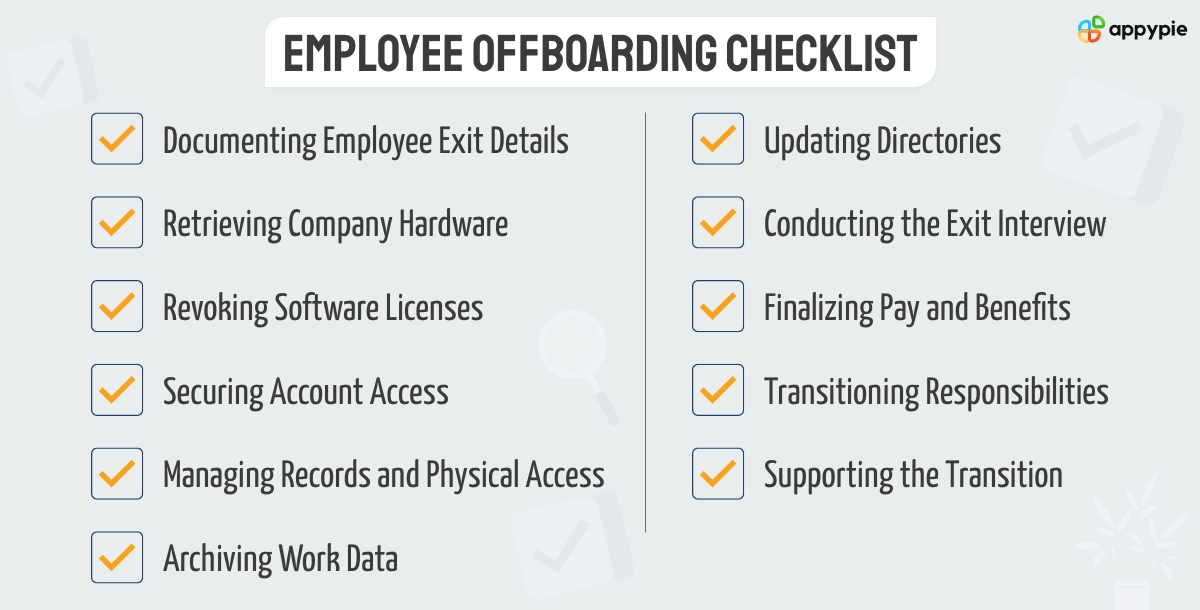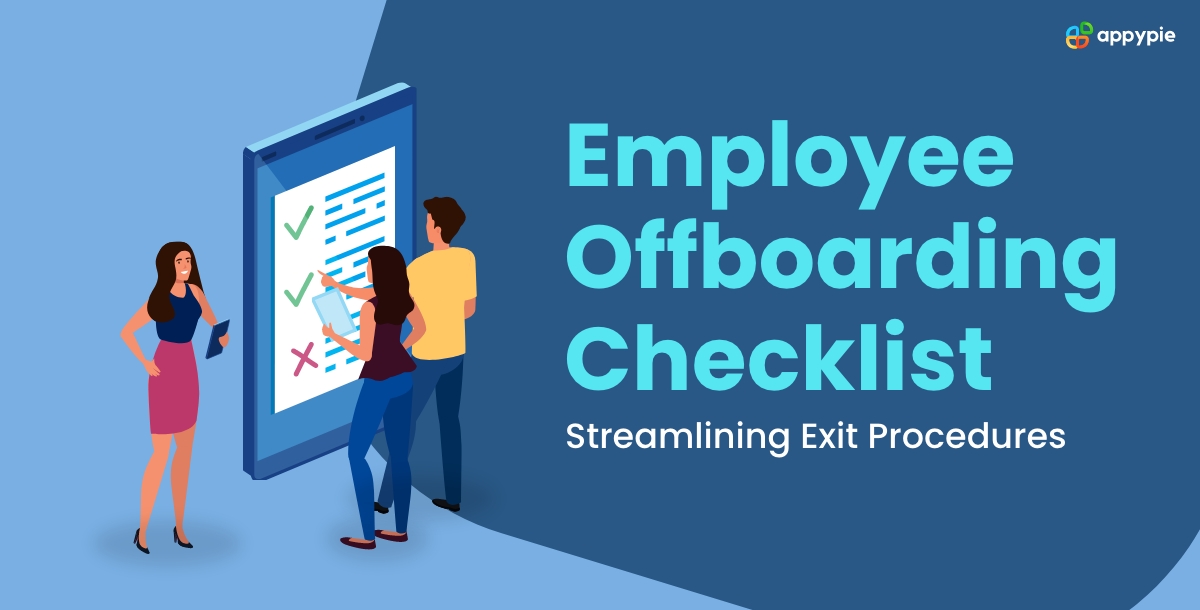11 – Step Employee Offboarding Checklist for a Smooth Transition

Navigating the complexities of employee offboarding can be a challenging task for any organization. However, with the right approach and tools, such as workflow automation tools, this process can be significantly simplified, ensuring a smooth transition for both the company and the departing employee. This guide aims to provide a comprehensive employee offboarding checklist, designed to assist businesses in managing this process efficiently and effectively, ensuring that nothing is overlooked.
What is Offboarding?
Offboarding is the process that takes place when an employee leaves a company, whether due to resignation, retirement, or termination. It involves a series of steps designed to ensure a smooth and orderly transition for both the departing employee and the organization. The offboarding process includes tasks such as returning company property, revoking access to company systems, conducting exit interviews, and finalizing payroll and benefits. The goal is to part ways on good terms, maintaining a positive relationship and securing the company's assets and information. Proper offboarding is crucial for protecting both the company's and the employee's interests, helping to ensure a professional and positive conclusion to the employment relationship. Including workflow automation planning tips in your offboarding strategy can streamline these tasks, making the process more efficient and less prone to errors, ultimately supporting a smoother transition.
Customizing Your Employee Offboarding Checklist in 11 Steps
- Documenting Employee Exit Details
- Retrieving Company Hardware
- Revoking Software Licenses
- Securing Account Access
- Managing Records and Physical Access
- Updating Directories
- Conducting the Exit Interview
- Finalizing Pay and Benefits
- Transitioning Responsibilities
- Supporting the Transition
- Archiving Work Data

Begin the offboarding process by gathering all necessary information about the departing employee, including their name, termination date, and other pertinent details. This step is crucial for organizing the offboarding process efficiently. Create a document titled with the employee's name followed by "Offboarding" to ensure it can be easily found. This document will serve as a central point for all information and actions related to the employee's departure, facilitating a smooth transition for both parties involved.
It's essential to collect all company-issued hardware from the departing employee. Implement a detailed inventory system, which could range from a basic spreadsheet to advanced IT asset management software, to keep track of and recover all devices allocated to the employee. This step prevents the loss of valuable company assets and ensures that all hardware is accounted for and can be prepared for future use.
Identify and revoke any desktop software licenses that were provided to the employee. Pay special attention to applications that require a license, including any specialized software specific to the employee's role within the company. This action ensures that software licenses are efficiently managed and reallocated as needed, preventing unnecessary expenses and maintaining software compliance.
Promptly revoke the departing employee's access to all sensitive and subscription-based accounts. For shared accounts, changing passwords is a critical step, and using a password manager can streamline this process. This measure is vital for protecting sensitive company information and ensuring that former employees cannot access company resources post-departure.
Update the employee's status to "terminated" in systems that require access to compensation information, like payroll and HR records. Also, ensure that any form of physical access, such as keycards or biometric entry, is revoked. This step is crucial for maintaining security and ensuring that former employees cannot access the premises or sensitive information after their departure.
Remove the departing employee's information from all public and internal directories to reflect their departure accurately. This update helps maintain an up-to-date representation of your team and prevents confusion regarding the current team members and their roles within the organization.
Exit interviews offer valuable insights into the employee's experience with the company. This feedback can highlight areas for organizational improvement and enhance the overall employee experience. Conducting an exit interview is a constructive way to understand the reasons behind the departure and identify opportunities for growth and development within the company.
Ensure that all financial obligations toward the departing employee are fulfilled, including the issuance of the final paycheck and any accrued benefits. This step is not only a legal requirement but also contributes to maintaining a positive relationship with the former employee, demonstrating the company's integrity and goodwill.
Inform the team and relevant stakeholders about the employee's departure and efficiently manage the transition of their responsibilities. This communication ensures that all parties are aware of the change and that there is a plan in place for the continuation of work without disruption, maintaining productivity and team morale.
Offer support to the departing employee during their transition, which could include assistance with job searches or providing letters of recommendation. This support reflects positively on the company's culture and can leave the employee with a favorable impression, potentially leading to positive referrals or the possibility of rehiring in the future.
Securely archive the departing employee's work data and documents in accordance with data protection regulations and company policies. This step ensures that valuable information is retained and protected, while also complying with legal requirements for data security and privacy.
Upon completing the checklist, upload the document to the employee's file for future reference and as proof of the offboarding process. This documentation is crucial for confirming the completion of the offboarding process and for security audits.
Why is an Offboarding Checklist Important?
An offboarding checklist plays a crucial role in ensuring a smooth transition when an employee leaves a company. Here are four key points highlighting the importance of an offboarding checklist:
- Ensures Compliance: The checklist helps the company stay compliant with legal and regulatory requirements by ensuring all necessary paperwork is completed and final paychecks are processed correctly.
- Protects Company Assets: It ensures that all company property, such as laptops, ID badges, and access cards, are returned, safeguarding the company's physical and digital assets.
- Maintains Security: By systematically revoking access to company systems and databases, the checklist helps prevent unauthorized access to sensitive information, maintaining the integrity of the company's data.
- Supports Positive Relationships: A thorough offboarding process, guided by a checklist, allows for a structured exit interview, offering closure and maintaining a positive relationship with departing employees, who could become future clients, partners, or even return as employees.
Best Practices for Managing Your Offboarding Checklist
- Reference Your Onboarding Checklist: Use the onboarding checklist as a guide to ensure all necessary accounts and assets are addressed during offboarding.
- Schedule Regular Reviews: Annually review your offboarding and onboarding checklists to ensure they remain aligned with current processes and technologies.
- Track Systems and Applications: Maintain an accurate inventory of all IT systems and applications, adding new items to the checklist as needed.
- Promote Accountability: Assign responsibility for each checklist item, setting deadlines and requiring sign-offs upon completion.
Common Offboarding Mistakes to Avoid
Offboarding is as crucial as onboarding in managing an employee's life cycle within an organization. However, it's often overlooked, leading to potential risks and missed opportunities. Here are four common offboarding mistakes to avoid:
- Neglecting a Formal Process : Failing to have a structured offboarding process can lead to chaos, with tasks falling through the cracks, such as not revoking access to company systems or forgetting to collect company property.
- Inadequate Communication : Not properly communicating an employee's departure can lead to confusion and rumors within the team. It's important to have a clear communication plan that respects the departing employee's privacy while keeping the team informed.
- Skipping the Exit Interview : Overlooking the exit interview means missing out on valuable feedback that could improve organizational practices and employee satisfaction. These insights are crucial for identifying areas of improvement.
- Forgetting to Update Systems and Records : Failing to promptly remove the departing employee from company systems, email lists, and internal directories can lead to security vulnerabilities and miscommunication. It's essential to have a checklist to ensure all necessary updates are made.
Best Tools for Employee Offboarding
When it comes to managing the employee offboarding process efficiently, leveraging the right software can make all the difference. Popular employee offboarding software solutions like Okta, BambooHR, and Aero Workflow have become essential tools for many organizations. These platforms offer a range of features designed to streamline the offboarding process, ensuring a smooth and secure transition for both the departing employee and the company.
Popular Integrations for Streamlining Employee Offboarding
Appy Pie facilitates seamless integrations, allowing businesses to streamline their employee offboarding process by connecting their favorite HR tools and apps, enhancing efficiency and automation.
- Create a Slack and Okta integration
- Create a BambooHR and Aero Workflow integration
- Create a Okta and Dropbox Integration
- Create a Google Sheets and Google Forms integration
- Create a Typeform and Google Sheets integration
- Create a Gmail and Airtable integration
Conclusion
Effective employee offboarding is essential for protecting company assets and information. By utilizing a comprehensive offboarding checklist, businesses can streamline the process, ensuring a secure and orderly transition. Remember, a well-managed offboarding process not only safeguards your organization but also respects the departing employee's contribution, fostering a positive and professional final impression.Incorporating these practices into your offboarding process will enhance efficiency, security, and compliance, ultimately contributing to the overall success and resilience of your organization.
For insights on optimizing this aspect of offboarding, explore our guide on the best digital asset management software, designed to help you maintain control over your digital resources efficiently.
Related Articles
- How to Convert Image to Text with Google Drive
- 200+ Stylish Bio for Instagram Ideas: Copy and Paste Fonts
- Conquer the “DNS Server Not Responding” Error with These Hacks!
- 504 Gateway Timeout Error: Understand, Fix, and Prevent
- Hard Sell vs. Soft Sell: Explained with Examples
- Why Facebook Debarred a Quiz App?
- Lead Nurturing Mastery: Unveiling Strategies and Statistics for 2024
- The Definitive Guide to the Right TikTok Video Size
- 10 Best GitLab Integrations for Better Code Reviews
- 7 Steps to Creative Chatbot Name (Some Interesting Bot Name Ideas)
